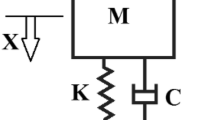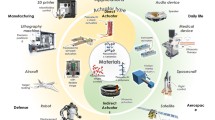Abstract
A folded two-degree-of-freedom piezoelectric vibration energy harvester has been proposed by several researchers including the authors. It is characterized by the reversal of the modal sequence, which enhances the electrical output power near a target operating frequency with very little eigenfrequency separation. However, no appropriate mathematical models have yet been developed, though a well-developed one would clarify the physical behaviors and allow efficient investigations of the effects of design parameters. In this work, a rigorous mathematical model based on the continuous Euler–Bernoulli beam theory is proposed for the first time. It is validated by both a finite element analysis and by experimental measurements. The validated mathematical model is then employed for a design parameter study with four design parameters, in this case the length of each component beam and the magnitude of each proof mass. For certain selected cases from the design parameter study sets, prototypes are fabricated and their performances are measured for verification of the design parameter study. Some useful observations are also drawn from the design parameter study for the design of a high-performance folded two-degree-of-freedom piezoelectric vibration energy harvester. Through all of the results presented in this work, it is shown that the proposed mathematical model will serve as an effective tool for the analysis and design of a folded two-degree-of-freedom piezoelectric vibration energy harvester.



















Similar content being viewed by others
References
Roundy, S., Wright, P. K., & Rabaey, J. (2003). A study of low level vibrations as a power source for wireless sensor nodes. Computer Communications, 26(11), 1131–1144.
Priya, S. and Inman, D. J., “Energy Harvesting Technologies,” Springer, 2009.
Erturk, A. and Inman, D. J., “Piezoelectric Energy Harvesting,” John Wiley & Sons, 2011.
Liu, H., Zhong, J., Lee, C., Lee, S.-W., & Lin, L. (2018). A comprehensive review on piezoelectric energy harvesting technology: Materials, mechanisms, and applications. Applied Physics Reviews, 5(4), 041306.
Kim, H. S., Kim, J.-H., & Kim, J. (2011). A review of piezoelectric energy harvesting based on vibration. International Journal of Precision Engineering and Manufacturing, 12(6), 1129–1141.
Erturk, A., & Inman, D. J. (2009). An experimentally validated bimorph cantilever model for piezoelectric energy harvesting from base excitations. Smart Materials and Structures, 18(2), 025009.
Sodano, H. A., Park, G., & Inman, D. J. (2004). Estimation of electric charge output for piezoelectric energy harvesting. Strain Journal, 40(2), 49–58.
Erturk, A., & Inman, D. J. (2008). Issues in mathematical modeling of piezoelectric energy harvesters. Smart Materials and Structures, 17(6), 065016.
Kim, J. E., & Kim, Y. Y. (2011). Analysis of piezoelectric energy harvesters of a moderate aspect ratio with a distributed tip mass. Journal of Vibration and Acoustics, 133(4), 041010.
Kim, J. E., Kim, H., Yoon, H., Kim, Y. Y., & Youn, B. D. (2015). An energy conversion model for cantilevered piezoelectric vibration energy harvesters using only measurable parameters. International Journal of Precision Engineering and Manufacturing-Green Technology, 2(1), 51–57.
Sun, C., Qin, L., Li, F., & Wang, Q.-M. (2009). Piezoelectric energy harvesting using single crystal Pb(Mg1/3Nb2/3)O3-XPbTiO3(PMN-PT) device. Journal of Intelligent Material Systems and Structures, 20(5), 559–568.
Challa, V. R., Prasad, M. G., & Fisher, F. T. (2009). A coupled piezoelectric-electromagnetic energy harvesting technique for achieving increased power output through damping matching. Smart Materials and Structures, 18(9), 095029.
Kim, H., Lee, S., Cho, C., Kim, J. E., Youn, B. D., & Kim, Y. Y. (2015). An experimental method to design piezoelectric energy harvesting skin using operating deflection shapes and its application for self-powered operation of a wireless sensor networks. Journal of Intelligent Material Systems and Structures, 26(9), 1128–1137.
Rupp, C. J., Evgrafov, A., Maute, K., & Dunn, M. L. (2009). Design of piezoelectric energy harvesting system: A topology optimization approach based on a multilayer plates and shells. Journal of Intelligent Material Systems and Structures, 20(16), 1923–1939.
Wickenheiser, A. M., & Garcia, E. (2010). Power optimization of vibration energy harvesters utilizing passive and active circuits. Journal of Intelligent Material Systems and Structures, 21(13), 1343–1361.
Tang, L., Yang, Y., & Soh, C. K. (2010). Toward broadband vibration-based energy harvesting. Journal of Intelligent Material Systems and Structures, 21(18), 1867–1897.
Nguyen, M. S., Yoon, Y.-J., & Kim, P. (2019). Enhanced broadband performance of magnetically coupled 2-DOF bistable energy harvester with secondary intrawell resonance. International Journal of Precision Engineering and Manufacturing-Green Technology, 6(3), 521–530.
Ma, P. S., Kim, J. E., & Kim, Y. Y. (2010). Power-amplifying strategy in vibration-powered energy harvesters. Proceedings of the SPIE, 7643, 76430O. https://doi.org/10.1117/12.848903
Aldraihem, O., & Baz, A. (2011). Energy harvester with a dynamic magnifier. Journal of Intelligent Material Systems and Structures, 22(6), 521–530.
Tang, X., & Zuo, L. (2011). Enhanced vibration energy harvesting using dual-mass systems. Journal of Sound and Vibration, 330(21), 5199–5209.
Ou, Q., Chen, X., Gutschmidt, S., Wood, A., Leigh, N., & Arrieta, A. F. (2011). An experimentally validated double-mass piezoelectric cantilever model for broadband vibration-based energy harvesting. Journal of Intelligent Material Systems and Structures, 23(2), 117–126.
Tang, L., & Yang, Y. (2012). A multiple-degree-of-freedom piezoelectric energy harvesting model. Journal of Intelligent Material Systems and Structures, 23(14), 1631–1647.
Kim, J. E. & Kim, Y. Y., “Energy harvester,” KOR Patent, No. 10-1061591, August 26, 2011.
Kim, J. E., & Kim, Y. Y. (2013). Power enhancing by reversing mode sequence in tuned mass-spring unit attached vibration energy harvester. AIP Advances, 3(7), 072103.
Wu, H., Tang, L., Yang, Y., & Soh, C. K. (2013). A novel two-degrees-of-freedom piezoelectric energy harvester. Journal of Intelligent Material Systems and Structures, 24(3), 357–368.
Wu, H., Tang, L., Yang, Y., & Soh, C. K. (2014). Development of a broadband nonlinear two-degree-of-freedom piezoelectric energy harvester. Journal of Intelligent Material Systems and Structures, 25(14), 1875–1889.
Hu, Y., & Xu, Y. (2014). A wideband vibration energy harvester based on a folded asymmetric gapped cantilever. Applied Physics Letters, 104(5), 053902.
Guan, Q. C., Ju, B., Xu, J. W., Liu, Y. B., & Feng, Z. H. (2013). Improved strain distribution of cantilever piezoelectric energy harvesting devices using H-shaped proof masses. Journal of Intelligent Material Systems and Structures, 24(9), 1059–1066.
Piezo Systems, Inc. Available from https://support.piezo.com/article/62-material-properties (cited on 14 January, 2019)
Acknowledgements
This research was supported by the Basic Science Research Program through the National Research Foundation of Korea (NRF) funded by the Ministry of Education (No. 2017R1D1A1B03028192) and also by the Center for Advanced Metamaterials (CAMM) funded by Korean Ministry of Science, ICT and Future Planning as the Global Frontier Project (CAMM-2014M3A6B3063711).
Author information
Authors and Affiliations
Corresponding author
Ethics declarations
Conflict of Interest
On behalf of all authors, the corresponding author states that there is no conflict of interest.
Additional information
Publisher's Note
Springer Nature remains neutral with regard to jurisdictional claims in published maps and institutional affiliations.
Rights and permissions
About this article
Cite this article
Kim, J.E., Lee, S. & Kim, Y.Y. Mathematical Model Development, Experimental Validation and Design Parameter Study of A Folded Two-Degree-of-Freedom Piezoelectric Vibration Energy Harvester. Int. J. of Precis. Eng. and Manuf.-Green Tech. 6, 893–906 (2019). https://doi.org/10.1007/s40684-019-00149-7
Received:
Revised:
Accepted:
Published:
Issue Date:
DOI: https://doi.org/10.1007/s40684-019-00149-7




